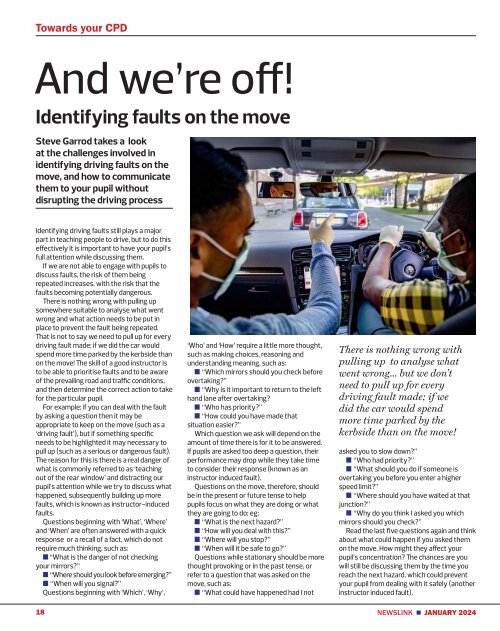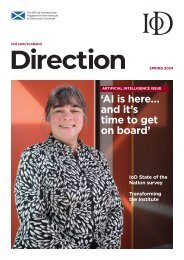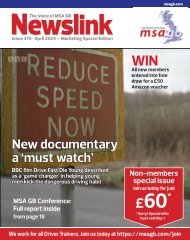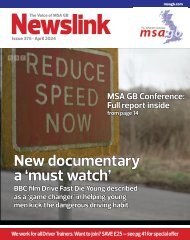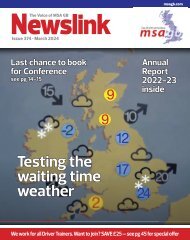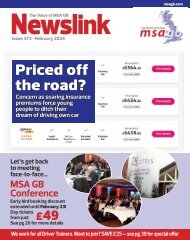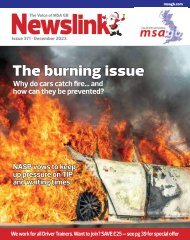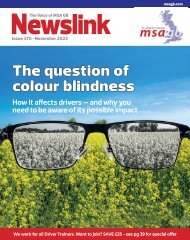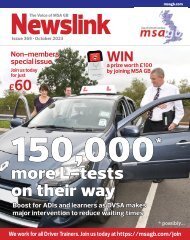NEWSLINK January 2024_compressed
Motor Schools Association membership magazine. Driver training and testing, road safety.
Motor Schools Association membership magazine. Driver training and testing, road safety.
You also want an ePaper? Increase the reach of your titles
YUMPU automatically turns print PDFs into web optimized ePapers that Google loves.
Towards your CPD<br />
And we’re off!<br />
Identifying faults on the move<br />
Steve Garrod takes a look<br />
at the challenges involved in<br />
identifying driving faults on the<br />
move, and how to communicate<br />
them to your pupil without<br />
disrupting the driving process<br />
Identifying driving faults still plays a major<br />
part in teaching people to drive, but to do this<br />
effectively it is important to have your pupil’s<br />
full attention while discussing them.<br />
If we are not able to engage with pupils to<br />
discuss faults, the risk of them being<br />
repeated increases, with the risk that the<br />
faults becoming potentially dangerous.<br />
There is nothing wrong with pulling up<br />
somewhere suitable to analyse what went<br />
wrong and what action needs to be put in<br />
place to prevent the fault being repeated.<br />
That is not to say we need to pull up for every<br />
driving fault made; if we did the car would<br />
spend more time parked by the kerbside than<br />
on the move! The skill of a good instructor is<br />
to be able to prioritise faults and to be aware<br />
of the prevailing road and traffic conditions,<br />
and then determine the correct action to take<br />
for the particular pupil.<br />
For example; if you can deal with the fault<br />
by asking a question then it may be<br />
appropriate to keep on the move (such as a<br />
‘driving fault’), but if something specific<br />
needs to be highlighted it may necessary to<br />
pull up (such as a serious or dangerous fault).<br />
The reason for this is there is a real danger of<br />
what is commonly referred to as ‘teaching<br />
out of the rear window’ and distracting our<br />
pupil’s attention while we try to discuss what<br />
happened, subsequently building up more<br />
faults, which is known as instructor-induced<br />
faults.<br />
Questions beginning with ‘What’, ‘Where’<br />
and ‘When’ are often answered with a quick<br />
response or a recall of a fact, which do not<br />
require much thinking, such as:<br />
n “What is the danger of not checking<br />
your mirrors?”<br />
n “Where should you look before emerging?”<br />
n “When will you signal?”<br />
Questions beginning with ‘Which’, ‘Why’,<br />
‘Who’ and ‘How’ require a little more thought,<br />
such as making choices, reasoning and<br />
understanding meaning, such as:<br />
n “Which mirrors should you check before<br />
overtaking?”<br />
n “Why is it important to return to the left<br />
hand lane after overtaking?<br />
n “Who has priority?”<br />
n “How could you have made that<br />
situation easier?”<br />
Which question we ask will depend on the<br />
amount of time there is for it to be answered.<br />
If pupils are asked too deep a question, their<br />
performance may drop while they take time<br />
to consider their response (known as an<br />
instructor induced fault).<br />
Questions on the move, therefore, should<br />
be in the present or future tense to help<br />
pupils focus on what they are doing or what<br />
they are going to do; eg:<br />
n “What is the next hazard?”<br />
n “How will you deal with this?”<br />
n “Where will you stop?”<br />
n “When will it be safe to go?”<br />
Questions while stationary should be more<br />
thought provoking or in the past tense, or<br />
refer to a question that was asked on the<br />
move, such as:<br />
n “What could have happened had I not<br />
There is nothing wrong with<br />
pulling up to analyse what<br />
went wrong... but we don’t<br />
need to pull up for every<br />
driving fault made; if we<br />
did the car would spend<br />
more time parked by the<br />
kerbside than on the move!<br />
asked you to slow down?”<br />
n “Who had priority?”<br />
n “What should you do if someone is<br />
overtaking you before you enter a higher<br />
speed limit?”<br />
n “Where should you have waited at that<br />
junction?”<br />
n “Why do you think I asked you which<br />
mirrors should you check?”<br />
Read the last five questions again and think<br />
about what could happen if you asked them<br />
on the move. How might they affect your<br />
pupil’s concentration? The chances are you<br />
will still be discussing them by the time you<br />
reach the next hazard, which could prevent<br />
your pupil from dealing with it safely (another<br />
instructor induced fault).<br />
18 <strong>NEWSLINK</strong> n JANUARY <strong>2024</strong>


